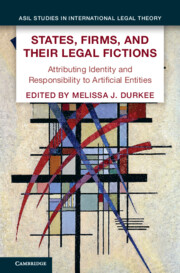 States, Firms, and Their Legal Fictions
States, Firms, and Their Legal Fictions Book contents
- States, Firms, and Their Legal Fictions
- ASIL Studies in International Legal Theory
- States, Firms, and Their Legal Fictions
- Copyright page
- Contents
- Contributors
- Acknowledgments
- 1 Introduction
- Part I International Attribution
- Part II Transnational Attribution
- 6 Corporate Structures and the Attribution Dilemma in Multinational Enterprises
- 7 Transnational Blame Attribution
- 8 Mind the Agency Gap in Corporate Social Responsibility
- Part III Domestic Attribution
- Part IV Conceptual Origins and Lineages
- Index
7 - Transnational Blame Attribution
The Limits of Using Reputational Sanctions to Punish Corporate Misconduct
from Part II - Transnational Attribution
Published online by Cambridge University Press: 29 February 2024
- States, Firms, and Their Legal Fictions
- ASIL Studies in International Legal Theory
- States, Firms, and Their Legal Fictions
- Copyright page
- Contents
- Contributors
- Acknowledgments
- 1 Introduction
- Part I International Attribution
- Part II Transnational Attribution
- 6 Corporate Structures and the Attribution Dilemma in Multinational Enterprises
- 7 Transnational Blame Attribution
- 8 Mind the Agency Gap in Corporate Social Responsibility
- Part III Domestic Attribution
- Part IV Conceptual Origins and Lineages
- Index
Summary
When corporations engage in misconduct, we rely on two types of sanctions to discipline them: legal and reputational. For various reasons, both types of sanctions have limitations. This chapter argues that a combination of legal and reputational sanctions for corporate misconduct can help to improve the effectiveness of blame attribution, deliver meaningful punishment for misconduct, and foster organizational change. For example, legal sanctions through lawsuits and government fines can trigger reputational sanctions that can unleash a subsequent wave of monetary costs because the publicity associated with the lawsuit or government fine can lead a corporation’s stakeholders to re-evaluate their relationship with it. Alternatively, legal rules can facilitate the operation of reputational markets by increasing information flows and thereby improving attribution of conduct to particular companies.
Keywords
- Type
- Chapter
- Information
- States, Firms, and Their Legal FictionsAttributing Identity and Responsibility to Artificial Entities, pp. 131 - 150Publisher: Cambridge University PressPrint publication year: 2024
